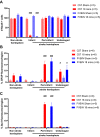Optimising the photothrombotic model of stroke in the C57BI/6 and FVB/N strains of mouse
- PMID: 35534531
- PMCID: PMC9085761
- DOI: 10.1038/s41598-022-11793-6
Optimising the photothrombotic model of stroke in the C57BI/6 and FVB/N strains of mouse
Abstract
The photothrombotic stroke model relies on the interaction between photosensitive-dye and light for clot formation. Interestingly, the relationship between the length of light exposure and stroke-outcome has never been examined. This model has yet to be established in the FVB/N strain, even though stroke-outcomes are strain-specific. Therefore, this study aimed to examine the effect of different lengths of light exposure in two strains of mice on photothrombotic stroke. Male FVB/N and C57Bl/6 mice were subjected to stroke using 15, 18, or 20-min light exposure. Mice underwent functional testing for up to 7 days. Infarct volume was assessed with thionin staining, and cellular responses to injury analysed via immunofluorescence at 7-days post-stroke. Blood brain barrier (BBB) breakdown was assessed using Evans blue dye at 4.5-h post-stroke. Increasing light exposure from 15 to 20-min increased infarct volume but not functional deficit. Interestingly, there were strain-specific differences in functional outcomes, with FVB/N mice having less deficit on the hanging wire test than C57BI/6 after 15-min of light exposure. The opposite was seen in the adhesive removal test. There was no difference in the number of neurons, astrocytes, microglia, macrophages, and T cells between the strains, despite FVB/N mice demonstrating greater BBB breakdown and an enlarged spleen post-stroke. Increasing light exposure systematically increases infarct volume but does not worsen functional outcomes. FVB/N and C57Bl/6 mice exhibit subtle differences in functional outcomes post stroke, which highlights the need to choose tests which are appropriate for the mouse strain being used.
© 2022. The Author(s).
Conflict of interest statement
The authors declare no competing interests.
Figures





Similar articles
-
Brain immune cell composition and functional outcome after cerebral ischemia: comparison of two mouse strains.Front Cell Neurosci. 2014 Nov 19;8:365. doi: 10.3389/fncel.2014.00365. eCollection 2014. Front Cell Neurosci. 2014. PMID: 25477780 Free PMC article.
-
Genetic background, gender, age, body temperature, and arterial blood pH have a major impact on myocardial infarct size in the mouse and need to be carefully measured and/or taken into account: results of a comprehensive analysis of determinants of infarct size in 1,074 mice.Basic Res Cardiol. 2012 Sep;107(5):288. doi: 10.1007/s00395-012-0288-y. Epub 2012 Aug 3. Basic Res Cardiol. 2012. PMID: 22864681 Free PMC article.
-
Anesthesia-Induced Hypothermia Attenuates Early-Phase Blood-Brain Barrier Disruption but Not Infarct Volume following Cerebral Ischemia.PLoS One. 2017 Jan 24;12(1):e0170682. doi: 10.1371/journal.pone.0170682. eCollection 2017. PLoS One. 2017. PMID: 28118390 Free PMC article.
-
Partially purified components of Uncaria sinensis attenuate blood brain barrier disruption after ischemic brain injury in mice.BMC Complement Altern Med. 2015 May 27;15:157. doi: 10.1186/s12906-015-0678-4. BMC Complement Altern Med. 2015. PMID: 26012470 Free PMC article.
-
Differential effects of the cell cycle inhibitor, olomoucine, on functional recovery and on responses of peri-infarct microglia and astrocytes following photothrombotic stroke in rats.J Neuroinflammation. 2021 Jul 31;18(1):168. doi: 10.1186/s12974-021-02208-w. J Neuroinflammation. 2021. PMID: 34332596 Free PMC article.
Cited by
-
Behavioral tests to assess short- and long-lasting sensorimotor deficits following transient focal cerebral ischemia in rodents.Pharmacol Rep. 2025 Jul 3. doi: 10.1007/s43440-025-00747-0. Online ahead of print. Pharmacol Rep. 2025. PMID: 40603827 Review.
-
Drug screening for ischemic stroke using larvae and adult zebrafish model: a review.Lab Anim Res. 2025 Jan 2;41(1):1. doi: 10.1186/s42826-024-00232-4. Lab Anim Res. 2025. PMID: 39743611 Free PMC article. Review.
-
The Photothrombotic Model of Ischemic Stroke.Methods Mol Biol. 2024;2746:225-235. doi: 10.1007/978-1-0716-3585-8_18. Methods Mol Biol. 2024. PMID: 38070093
-
TRPC Channels Activated by G Protein-Coupled Receptors Drive Ca2+ Dysregulation Leading to Secondary Brain Injury in the Mouse Model.Transl Stroke Res. 2024 Aug;15(4):844-858. doi: 10.1007/s12975-023-01173-1. Epub 2023 Jul 18. Transl Stroke Res. 2024. PMID: 37462831 Free PMC article.
-
OCT-PAM dual-mode imaging to evaluate early ischemic stroke in rats.J Cereb Blood Flow Metab. 2025 Aug 20:271678X251369613. doi: 10.1177/0271678X251369613. Online ahead of print. J Cereb Blood Flow Metab. 2025. PMID: 40832974 Free PMC article.
References
MeSH terms
LinkOut - more resources
Full Text Sources
Medical

